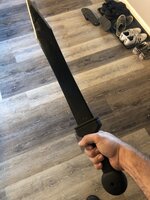Staff Member
Gold Supporter
Bronze Lifetime
- Messages
- 23,246
- Reactions
- 111,387
Mountain men carried knives...who would have thunk it...? 
The two most common types were :
The Butcher knife *
And
The scalping knife.
These two names are found all throughout period fur trade accounts , ledger books , journals and narratives.
*Yes I know that Butchers use a lot of different knives of different shapes....I can only say that in the period accounts , that is the name they used.
The term "Trade Knife" is also seen fairly commonly.
A Trade Knife was simply a knife made for use in the fur trade.
What gets confusing is that the three terms , Butcher , Scalper and Trade Knife , are often used interchangeably.
Pictured below are some knives that would have been very familiar to the mountain man or Indian.
All of the knives below are old as in from the 1890's or so....
And while they are "newer" than say a knife used in the rendezvous period of the fun trade ( 1825- 1840 )
They are indeed the same shape , styling and size that would have been used then.
Most Trade knives ( Butcher or scalper style ) had blades between 5 1/2 and 8 inches long. ( carbon steel )
Sported hard wood handles...and a tapered half tang....held to the handles by a series of three to five pins.
in the picture below you will see three knives , one of the "Scalper" and two of the "Butcher pattern.
Again , all three date from the 1890's to 19 teens.
All three are still in use today , as camping and hunting knives.
The top one is the "Scalper"pattern
it was made by "Universal " ( they went under in 1920 )
It originally had a hard wood handle that broke apart...I added the antler handle as a replacement.
Antler was used a lot as a knife handle...usually in a homemade knife...not so common in a factory "trade" of "scalper" knife...
But I do like the look.
The blade is 5 1/2 inches long.
The next knife is a Christopher & Johnson knife from Sheffield England.
The knife is of the "Butcher" pattern.
The blade is also 5 1/2 inches long.
It came to me without a handle....I made a handle from compressed cow horn and added some large checkering ...
This was seen from time to time on period knifes....
The third knife is a Russel Green River "Butcher" knife...
7 inch blade...hard wood handle.

Pocket knives were also used....the two most common were the "Penny Knife" and the Barlow knife.
Also as early as 1837...there are references to "Bowie" knives...being carried by mountain men.
Now a real easy way to start a "knife fight" is to say :
A mountain man carried a carried a Bowie knife and here is what it looked like....
I have my own ideas of what a fur trade period Bowie Knife looked like...
But that might be a subject best left for a different thread.
Andy
The two most common types were :
The Butcher knife *
And
The scalping knife.
These two names are found all throughout period fur trade accounts , ledger books , journals and narratives.
*Yes I know that Butchers use a lot of different knives of different shapes....I can only say that in the period accounts , that is the name they used.
The term "Trade Knife" is also seen fairly commonly.
A Trade Knife was simply a knife made for use in the fur trade.
What gets confusing is that the three terms , Butcher , Scalper and Trade Knife , are often used interchangeably.
Pictured below are some knives that would have been very familiar to the mountain man or Indian.
All of the knives below are old as in from the 1890's or so....
And while they are "newer" than say a knife used in the rendezvous period of the fun trade ( 1825- 1840 )
They are indeed the same shape , styling and size that would have been used then.
Most Trade knives ( Butcher or scalper style ) had blades between 5 1/2 and 8 inches long. ( carbon steel )
Sported hard wood handles...and a tapered half tang....held to the handles by a series of three to five pins.
in the picture below you will see three knives , one of the "Scalper" and two of the "Butcher pattern.
Again , all three date from the 1890's to 19 teens.
All three are still in use today , as camping and hunting knives.
The top one is the "Scalper"pattern
it was made by "Universal " ( they went under in 1920 )
It originally had a hard wood handle that broke apart...I added the antler handle as a replacement.
Antler was used a lot as a knife handle...usually in a homemade knife...not so common in a factory "trade" of "scalper" knife...
But I do like the look.
The blade is 5 1/2 inches long.
The next knife is a Christopher & Johnson knife from Sheffield England.
The knife is of the "Butcher" pattern.
The blade is also 5 1/2 inches long.
It came to me without a handle....I made a handle from compressed cow horn and added some large checkering ...
This was seen from time to time on period knifes....
The third knife is a Russel Green River "Butcher" knife...
7 inch blade...hard wood handle.

Pocket knives were also used....the two most common were the "Penny Knife" and the Barlow knife.
Also as early as 1837...there are references to "Bowie" knives...being carried by mountain men.
Now a real easy way to start a "knife fight" is to say :
A mountain man carried a carried a Bowie knife and here is what it looked like....
I have my own ideas of what a fur trade period Bowie Knife looked like...
But that might be a subject best left for a different thread.
Andy







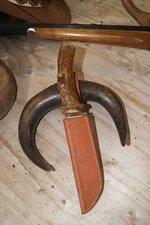
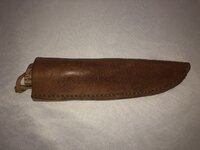
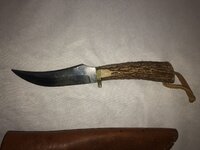

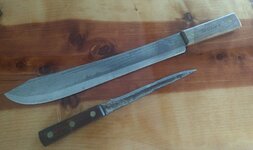
 . 14in blade, 20in overall, its definitely reminiscent of a short sword.
. 14in blade, 20in overall, its definitely reminiscent of a short sword.